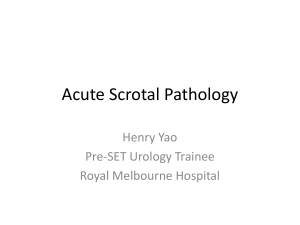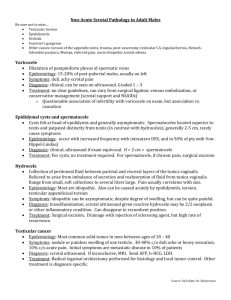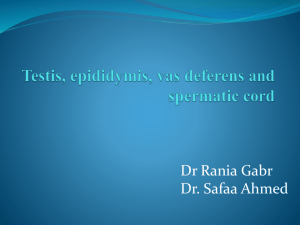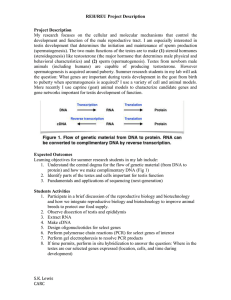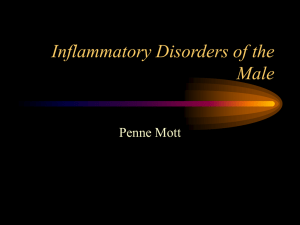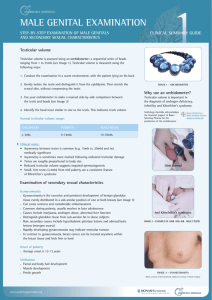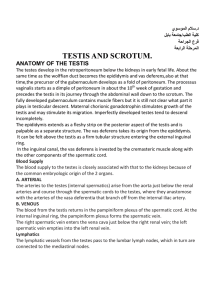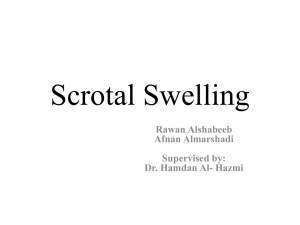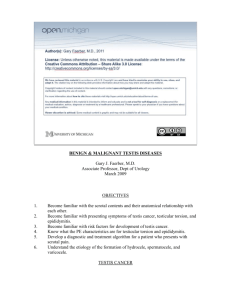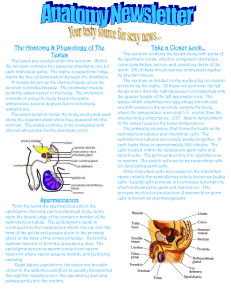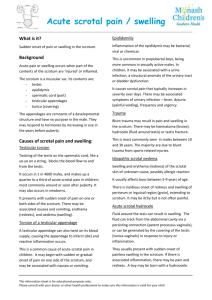TESTIS AND SCROTUM. ANATOMY OF THE TESTIS
advertisement
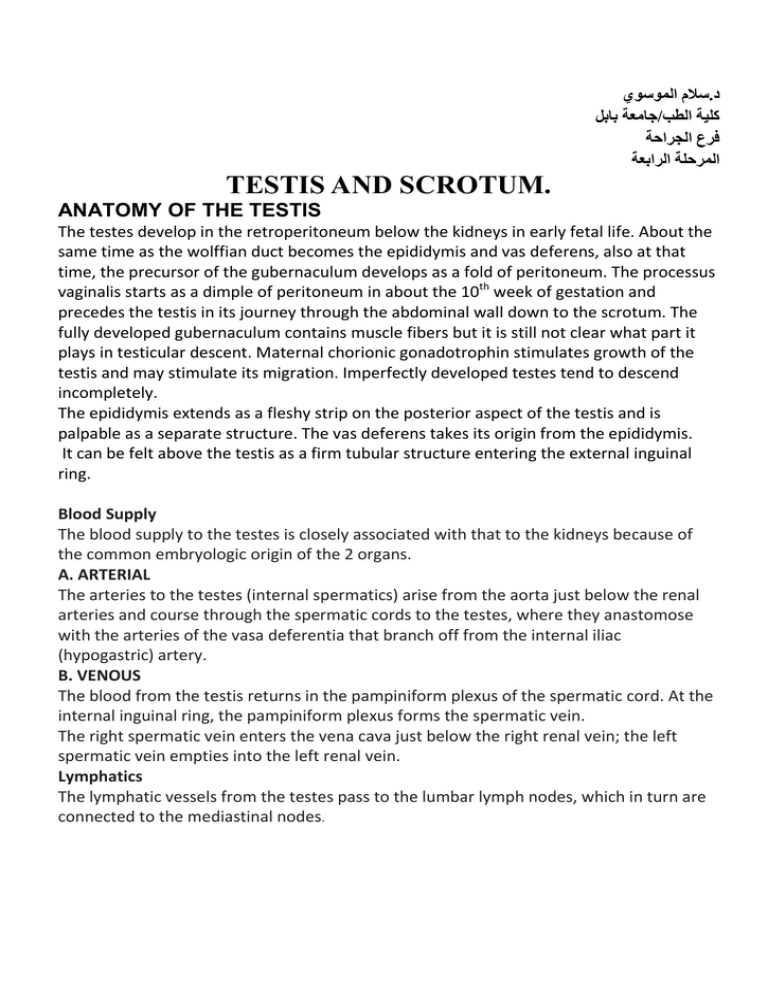
سالم الموسوي.د جامعة بابل/كلية الطب فرع الجراحة المرحلة الرابعة TESTIS AND SCROTUM. ANATOMY OF THE TESTIS The testes develop in the retroperitoneum below the kidneys in early fetal life. About the same time as the wolffian duct becomes the epididymis and vas deferens, also at that time, the precursor of the gubernaculum develops as a fold of peritoneum. The processus vaginalis starts as a dimple of peritoneum in about the 10th week of gestation and precedes the testis in its journey through the abdominal wall down to the scrotum. The fully developed gubernaculum contains muscle fibers but it is still not clear what part it plays in testicular descent. Maternal chorionic gonadotrophin stimulates growth of the testis and may stimulate its migration. Imperfectly developed testes tend to descend incompletely. The epididymis extends as a fleshy strip on the posterior aspect of the testis and is palpable as a separate structure. The vas deferens takes its origin from the epididymis. It can be felt above the testis as a firm tubular structure entering the external inguinal ring. Blood Supply The blood supply to the testes is closely associated with that to the kidneys because of the common embryologic origin of the 2 organs. A. ARTERIAL The arteries to the testes (internal spermatics) arise from the aorta just below the renal arteries and course through the spermatic cords to the testes, where they anastomose with the arteries of the vasa deferentia that branch off from the internal iliac (hypogastric) artery. B. VENOUS The blood from the testis returns in the pampiniform plexus of the spermatic cord. At the internal inguinal ring, the pampiniform plexus forms the spermatic vein. The right spermatic vein enters the vena cava just below the right renal vein; the left spermatic vein empties into the left renal vein. Lymphatics The lymphatic vessels from the testes pass to the lumbar lymph nodes, which in turn are connected to the mediastinal nodes. Undescended testes(cryptorchidism+ectopic testes) Cryptorchidism (derived from the Greek κρυπτός, kryptos, meaning hidden and ὄρχις, orchis, meaning testicle) is the absence of one or both testes from the scrotum. It is the most common birth defect regarding male genitalia. In unique cases, cryptorchidism can develop later in life, often as late as young adulthood. About 3% of full-term and 30% of premature infant boys are born with at least one undescended testis. However, about 80% of cryptorchid testes descend by the first year of life (the majority within three months), making the true incidence of cryptorchidism around 1% overall. A testis absent from the normal scrotal position can be: 1. found anywhere along the "path of descent" from high in the posterior (retroperitoneal) abdomen, just below the kidney, to the inguinal ring; 2. found in the inguinal canal; 3. ectopic, that is, found to have "wandered" from that path, usually outside the inguinal canal and sometimes even under the skin of the thigh, the perineum, the opposite scrotum, or the femoral canal. 4. found to be undeveloped (hypoplastic) or severely abnormal (dysgenetic); 5. found to have vanished (also see anorchia). About two thirds of cases without other abnormalities are unilateral; one third involve both testes. Risks associated with undescended testes: 1. psychological problems when the boy is grown. 2. reduced fertility (subfertility) and infertility. 3. increased risk of testicular germ cell tumors. 4. Increase susceptibility to testicular torsion and infarction and inguinal hernias Treatment: "Usually the testicle will descend into the scrotum without any intervention during the first year of life", but to reduce these risks, undescended testes can be brought into the scrotum in infancy by a surgical procedure called an orchiopexy usually done after the 1st year of life if the testes failed to descend . a testis observed in the scrotum in early infancy can occasionally "reascend" (move back up) into the inguinal canal. A testis which can readily move or be moved between the scrotum and canal is referred to as retractile testis and usually not need treatment. Hydrocele: A hydrocele is an abnormal collection of serous fluid in a part of the processus vaginalis, usually the tunica vaginalis. .it is either congenital or Acquired hydrocele which is either primary( idiopathic) or secondary to testicular disease. Etiology: A hydrocele can be produced in four different ways (Fig. 75.8): • by excessive production of fluid within the sac, e.g. secondary hydrocele; • by defective absorption of fluid; this appears to be the explanation for most primary hydroceles although the reason why the fluid is not absorbed is obscure. • by interference with lymphatic drainage of scrotal structures as post operative hydrocele. • by connection with the peritoneal cavity via a patent processus vaginalis (congenital). Clinical features Hydroceles are typically translucent and it is possible to ‘get above the swelling’ on examination of the scrotum. Primary vaginal hydrocele is most common in middle and later life but can also occur in older children. The condition is particularly common in hot countries. Because the swelling is usually painless and gradually increase in size it may reach a prodigious size before the patient presents for treatment. The testis may be palpable within a lax hydrocele, but an ultrasound scan is necessary to visualize the testis if the hydrocele sac is tense. Treatment : Congenital hydroceles are treated by herniotomy if they do not resolve spontaneously. Acquired hydrocele may be treated surgically. Varicocele A varicocele is defined as dilated and tortuous veins within the pampiniform plexus of scrotal veins. It is the most surgically correctable cause of male subfertility. The varicocele is a disease of puberty and is only rarely detected in boys <10 years of age. A left-sided varicocele is found in 15% of healthy young men. In contrast, the incidence of a left varicocele in subfertile men approaches 40%. Bilateral varicoceles are uncommon. In general, varicoceles do not spontaneously regress. The cornerstone of varicocele diagnosis rests on an accurate physical examination. Several anatomic features contribute to the predominance of left-sided varicoceles. The left internal spermatic vein is longer than the right; in addition, it usually joins the left renal vein at right angles. The right internal spermatic vein has a more oblique insertion into the inferiorvena cava. This particular anatomy in the standing man may cause higher venous pressures to be transmitted to the left scrotal veins and result in retrograde reflux of blood into the pampiniform plexus. Varicoceles are associated with testicular atrophy and varicocele correction can reverse atrophy in adolescents. There is indisputable evidence that the varicocele affects semen quality. In fact, a classic semen analysis pattern has been attributed to varicoceles in which low sperm count and motility is found in conjunction with abnormal sperm morphology. The finding of semen abnormalities constitutes the main indication for varicocele surgery in infertile men. Precisely how a varicocele exerts an effect on the testicle remains unclear. Several theories have been postulated; it is likely that a combination of effects results in infertility. Pituitary-gonadal hormonal dysfunction, internal spermatic vein reflux of renal or adrenal metabolites, and an increase in hydrostatic pressure associated with venous reflux are also postulated effects of a varicocele. The most intriguing theory of how varicoceles affect testis function invokes an inhibition of spermatogenesis through the reflux of warm blood around the testis, with disruption of the normal countercurrent heat exchange balance and elevation of intratesticular temperature. Dx.: precise physical exam. With or without Doppler scrotal U/S. Treatment: surgery(varicocelectomy). Testicular torsion (torsion of the spermatic cord): occurs when the spermatic cord (from which the testicle is suspended) twists, cutting off the testicle's blood supply, causing ischemia of the testis affected. Etiology: some cong. Anomalies may be risk factors for development of testicular torsion as: • High investment of the tunica vaginalis causes the testis to hang within the tunica like a clapper in a bell . "bell-clapper deformity". • Separation of the epididymis from the body of the testis permits torsion of the testis on the pedicle that connects the testis with the epididymis . Normally, when there is a contraction of the abdominal muscles, the cremaster contracts as well. In the presence of one of the abnormalities described above, the spiral attachment of the cremaster favors rotation of the testis around the vertical axis. Straining at stool, lifting a heavy weight and coitus are all possible precipitating factors. Alternatively, torsion may develop spontaneously during sleep. Summary box 75.4 The diagnosis: can be made clinically Testicular torsion usually presents with acute, diffuse and sever testicular pain . O/E: scrotal swelling and tenderness, loss of polarity of the testis(horizontal lie testis), high ridding testis and there is often an absent or decreased cremasteric reflex . an urgent Doppler scrotal ultrasound is helpful in evaluation. Irreversible ischemia begins around six hours after onset and emergency diagnosis and treatment is required within this time in order to minimize necrosis and to improve the chance of salvaging the testicle. Imaging A doppler ultrasound scan, also called a high-frequency transducer sonography and including pulsed color Doppler imaging, of the scrotum is nearly 100% accurate at detecting torsion. It is identified by the absence of blood flow in the twisted testicle, which distinguishes the condition from epididymitis. Radionuclide scanning of the scrotum is the most accurate, diagnostic, imaging technique, but it is not routinely available, particularly with the urgency that might be required. The agent of choice for this purpose is technetium-99m. Treatment: With prompt diagnosis and treatment the testicle can usually be preserved. Typically, when a torsion takes place, the surface of the testicle has rotated towards the midline of the body . Non-surgical correction can sometimes be accomplished by manually rotating the testicle in the opposite direction (i.e., outward, towards the thigh); if this is initially unsuccessful, a forced manual rotation in the other direction may correct the problem. The success rate of manual detorsion is not known with confidence. Testicular torsion is a surgical emergency that requires immediate intervention(detorsion with orchiopexy) to restore the flow of blood. If treated either manually or surgically within six hours, there is a high chance (approx. 90%) of preserving the testicle. At 12 hours the rate decreases to 50%; at 24 hours it drops to 10%, and after 24 hours the rate of preservation approaches 0. Intermittent testicular torsion (ITT). A variant is a less serious but chronic condition called intermittent testicular torsion (ITT), characterized by the symptoms of torsion but followed by eventual spontaneous detortion and resolution of pain. Nausea or vomiting may also occur. Though less pressing, such individuals are at significant risk of complete torsion and possible subsequent orchiectomy and the recommended treatment is elective bilateral orchiopexy. Ninety-seven percent of patients who undergo such surgery experience complete relief from their symptoms. Extravaginal testicular torsion. A torsion which occurs outside of the tunica vaginalis, when the testis and gubernaculum can rotate freely, is termed an extravaginal testicular torsion. This type occurs exclusively in newborns. Neonates experiencing such a torsion present with scrotal swelling, discoloration, and a firm, painless mass in the scrotum. Such testes are usually necrotic from birth and must be removed surgically. Torsion of testicular appendages: This type of torsion is the most common cause of acute scrotal pain in boys ages 7–14. Its appearance is similar to that of testicular torsion but the onset of pain is more gradual. Palpation reveals a small firm nodule on the upper portion of the testis which displays a characteristic "blue dot sign." This is the appendix of the testis which has become discolored and is noticeably blue through the skin. Unlike other torsions, however, the cremasteric reflex is still active. Typical treatment involves the use of over-the-counter analgesics and the condition resolves within 2–3 days. Idiopathic scrotal edema : Usually occur between 4-12 years . It ccc. By painful scrotal swelling that may extend to the perineum and penis. Usually resolve spontaneously but may recur. Insect bite of the scrotum: It also cause painful scrotal swelling. The punctum of the insect usually can be identified. It can be treated with analgesia and anti histamine. Testicular tumors: Most testicular neoplasms are malignant; testicular neoplasm is one of the most common forms of cancer in young men. Of primary testicular tumors 90 – 95 % are germ cell tumors ( seminoma & non seminoma), while the remaining 5 % are non germ cell tumour (Leydig cell, Sertoli cell and gonadoblastoma).. Risk factor: 1-Race. The incidence in black is about one fourth in white people. 2-socioeconomic class: The disease is twice more common in high socioeconomic class than in lower class. 3-Cryptorchid testis : 7-10 % of tumors occur in patients with history of cryptorchidism, the risk is also higher in the contralateral normally descended testis. The risk is higher in intraabdonimal ( 1:20) and lower in inguinal (1:80) testis. 4- Exogenous estrogen administration to the mother during pregnancy is also associated with increase risk. 5-Trauma. 6- Infection associated atrophy. The disease is slightly more common on the right side ( correlate with late descend of the right testis ), 1-2 % of cases are bilateral and most of these are seminoma. CLASSIFICATION: *Germ cell tumors classified in to: A-Seminoma (35 %) Classic seminoma (85 % of seminoma) Anaplastic seminoma ( 5 -10 %) Spermatocytic seminoma ( 5 – 10 ) B- Non seminoma: 1. Emberyonal cell carcinoma (20 %):- two variant types which are: Adult type and infantile type(yolk sac tumors). 2.Teratoma ( 5 % ) 3. Chorio carcinoma ( less than 1 %) Mixed tumor up to 25 % C. carcinoma insitu. 5.2 % *Non germ cell tumors (>5%) *Secondary testicular tumors : as lymphoma . Metastatic spread: With exception of choriocarcinoma which charectarized by blood born metastasis early in the caurse of the disease , all other germ cell tumors typically spread by step wise lymph node fashion .LN drainage of the testes are the para aortic L.N.extend from T4 to L1 but are concentrated at the level of renal hillum. The primary riding site of the right testis is interaortocaval area at the renal hillum then spread in step wise fashion to the precaval, preaortic, paracaval, right common iliac and right external iliac LN.The primary landing site of the left testis is the paraaortic area at the level of left renal hillum, and then spread to the pre aortic left common iliac and left external iliac LN in step wise fashion. In the absence of disease ,on the left side no crossover metastasis to the right side have ever been identified however right to left crossover metastasis are common. Scrotal violation or invasion of tunica albugina may result in inguinal LN metastasis while invasion of epididymis or spermatic cord may allow spread to obturator or distal external iliac LN. Blood metastasis may occur to the lung, liver, brain, bone, kidney and adrenals. Choriocarcinoma characterized by early blood born spread to the lung and have predilection of unusual site of metastasis such as the spleen. CLINLCAL PRESENTATION: A- Symptoms: Painless scrotal mass is the most common presentation. acute scrotal pain due to infarction or bleeding in the tumor may be the presenting symptom in 10 % , another 10 % of patients may presented with symptom of advanced disease ( bone pain, cough, wt. loss etc). The disease may be asymptomatic in 10 % of patient and discovered by doctor or patient sexual partner. Approximately 10% of patients present with symptoms related to metastatic disease. Back pain (retroperitoneal metastases involving nerve roots) is the most common symptom. Other symptoms include cough or dyspnea (pulmonary metastases); anorexia, nausea, or vomiting (retroduodenal metastases); bone pain (skeletal metastases);and lower extremity swelling (venacaval obstruction). B- Signs: A testicular mass or diffuse enlargement is found in most cases. The mass is typically firm and non tender and the epididymis should be easily separable from it. A hydrocele may accompany the testicular tumor and help to camouflage it. Transillumination of the scrotum can help to distinguish between these entities. General examination may reveal sign of advanced disease Gynaecomastia present in about 5 % of patient with germ cell tumors. C-INVESTIGATIONS: 1-Scrotal U/S: any hypo echoic area inside the testis should be considered as cancer until prove otherwise. 2- CXR. To detect any metastasis. 3- Abdominal and retroperitoneal contrast enhanced CT scan for staging. 4- Tumor markers. Tumor marker used for diagnosis of tumor, evaluation of response to treatment, staging and assessment of prognosis and these include: A- Alfa fetoprotein: is glycoprotein with M. wt. 70000 daltons and t 1/2 of 4-6 days, usually present in only trace amount after tha age of 1 year, it elevated in varying degrees in non seminoma , it never elevated in pure seminoma. B- Human chorionic gonadotropine: is glycoprotein with M wt. of 38000 daltons and t 1/2 of 24 hour, consist of 2 subunits alfa and beta the alfa subunit is similar to that found in LH, FSH, and TSH. while the beta subunit is unique to hCG. It ss most commonly elevated in non sminoma but it also elevated in 5 – 10 % of seminoma. C- Lactic acid dehydrogenase: is a cellular enzyme with molecular wt. of 134000 daltons , have 5 isoenzymes found in muscle, liver kidney and brain. Elevation of LAD especially isoenzyme 1 correlate with tumor burden in non seminoma it may also elevated in seminoma. Clinical Staging: Numerous clinical staging systems have also been suggested for seminoma. A stage I lesion is confined to the testis. Stage II has retroperitoneal nodal involvement (IIA is <2 cm, IIB is>2 cm). Stage III has supra diaphragmatic nodal involvement or visceral involvement. The TNM classification of American Joint Committee (1996) has attempted to standardize clinical stages. TREATMENT: Radical orchiectomy is the final step in diagnosis and the first step in treatment, it involve early ligation of the spermatic cord and removal of the testis , spermatic cord and their coverings through a groin incision. Additional therapy depends on the type and stage of the disease. *Seminoma…………..Low stage………… radiotherapy High stage………. chemotherapy ( 3 cycle of PEB regimen) *Non seminoma………Low stage………..surveillance or modified retroperitoneal lymph node dissection (RPLND) High stage………..chemotherapy ± RPLND. *Non germ cell tumors (mostly Leydig cell tumors)……… Radical orchiectomy is the initial treatment for Leydig cell tumors. Clinical staging is similar to that for germ cell tumors. RPLND is recommended for malignant lesions
